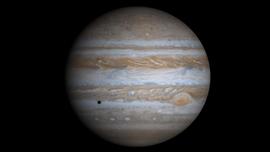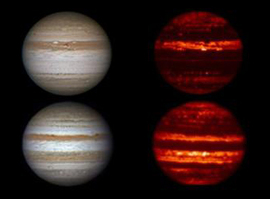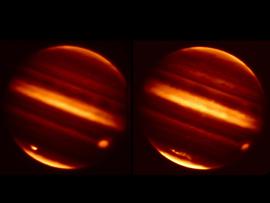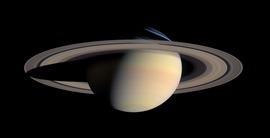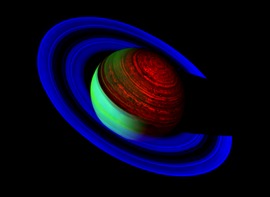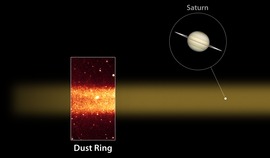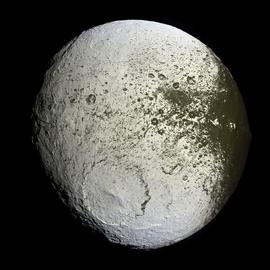Jupiter & Saturn
Jupiter and Saturn are the biggest planets in our Solar System. Infrared observations of these gas giants have mapped weather patterns, observed asteroids and comets crashing through their atmospheres, and discovered a huge new ring around Saturn.
Jupiter
Jupiter, the King of the Planets, is a gas giant, which means that it's made mostly of gases like hydrogen and helium, and that it doesn't have a solid surface in the way that rocky planets like Earth do. With a temperature of 130 K (-140 C, -230 F), it's so cold that it gives off most of its energy in the infrared. In fact, Jupiter gives off almost twice as much heat as it receives from the Sun. It's able to do this because it has its own internal heat source, powered by the slow gravitational collapse that started when the planet first formed. Astronomers estimate that Jupiter is currently shrinking by almost 2 cm per year!
Jupiter's Atmosphere
Heat from the interior of Jupiter causes circulation patterns in the atmosphere, with warm gas rising and cooling, before sinking back into the depths of the planet. This process is called convection, and it causes the different colored bands in Jupiter's atmosphere. The light colored bands, called "zones," are the rising areas, while the dark colored regions, or "belts," are the sinking gas. The different colors come from their different chemical compositions; astronomers think that the darker colored belts contain hydrocarbons - molecules that are made from hydrogen, carbon, and oxygen, which turn a darker color when exposed to the Sun's ultraviolet light. The rising zones, meanwhile, soar high into the atmosphere, and contain clouds of ammonia ice crystals that reflect sunlight, and block the view of the darker layers below, just like clouds here on Earth.
Atmosphere in the Infrared
If we look in the infrared, we can see that the ammonia ice clouds that shine so brightly in visible light look darker in the infrared, showing that they are cooler. The clouds don't just block our view of the lower layers, they also block the heat that's being generated from deeper in the planet, making those areas look colder than the belts.
The sinking gas in the belts, on the other hand, forms no cloud cover, and so we see deep into Jupiter's atmosphere where it is far warmer than at the tops of the clouds. The belts glow brightly in the infrared, as they pump the heat from the planet's interior out into the Universe.
Infrared observations can also tell us a lot about the composition of the clouds. Methane, one of the main components of Jupiter's atmosphere, heavily absorbs some wavelengths of infrared light. If we look in those specific wavelengths, we find that areas containing a lot of methane look very dark compared to the surrounding areas. This method can be used by astronomers to map the location and movement of different gases that make up the atmosphere.
Great Red Spot
One of the most famous features on Jupiter's surface is its Great Red Spot, a storm that’s been raging on the planet for over 400 years. It's so wide that about three Earths could fit within its boundaries. It's not the only storm, though -- two smaller ones nicknamed Oval BA and Little Red Spot have been churning alongside the Great Red Spot for many years. Infrared observations show complex swirls of warmer and cooler areas within the storms, and allow astronomers to track the heat flow and temperature patterns in their centers.
Cosmic Collisions
Jupiter has a rather violent history of getting hit by various celestial visitors. In 1994, a large comet called Shoemaker-Levy 9 crashed into the planet, leaving massive dark scars across the planet that lasted for several months. Then, in July 2009, another collision by an object about the size of the Titanic crashed into the planet causing an ocean-size scar. Infrared telescopes picked up this collision as a bright spot that gradually stretched out into a bright line as the hot lower layers of the planet were thrown up into the upper atmosphere by the collision. The infrared data allowed astronomers to observe the atmospheric temperatures and chemical conditions resulting from the 2009 impact, and enabled them to get a "taste" of the chemicals in Jupiter's lower layers.
Searing temperatures and the presence of blistering hot ammonia flooding up from deep within Jupiter's atmosphere revealed that the debris from the 2009 impact was heavier than the debris from comet Shoemaker-Levy 9, leading astronomers to conclude that the 2009 “impactor” was a rocky asteroid rather than an icy comet.
We've learned a lot by studying impacts like these. As a matter of fact, we now think that Jupiter is vital to the very survival of life here on Earth. Thanks to its location and its enormous gravitational pull, the King of the Planets acts as a gatekeeper, sweeping up comets and asteroids that might otherwise crash into Earth!
Saturn
The beauty of Saturn, the Lord of the Rings, has fascinated everyone who has ever seen it through even a small telescope. Like Jupiter, Saturn is a gas giant, which means it's mostly made of gases like hydrogen and helium, and it doesn’t have a solid surface in the way that rocky planets like Earth do.
Saturn is mainly made of hydrogen and helium gas. Its density is so low that it would float in water.
Also like Jupiter, Saturn gives off almost twice as much energy as it receives from the Sun, because it has its own internal heat source, powered by the slow gravitational collapse that started when the planet first formed. But even with this internal heat, Saturn is colder than Jupiter because it’s farther away from the Sun.
With the extremely cold temperatures in the Saturnian system, ranging from about 55 K to 110 K (-220 C to -160 C, -360 F to -260 F), Saturn, its rings (which are made out of particles of ice and dust), and its moons give off most of their energy at infrared wavelengths.
Saturn's Atmosphere
The night side of Saturn and its north polar region are dominated by infrared energy that wells up from deep within the planet's atmosphere. Varying amounts of upper atmospheric clouds block the infrared light, causing a banded and speckled appearance that constantly shifts due to Saturn's strong winds.
Lit from below by Saturn's internal infrared glow, bright areas show where the cloud cover is thinnest, allowing the heat from the planet's interior to blaze through. The northern hemisphere is almost twice as bright as the southern hemisphere. Scientists think this is because there are fewer high-level fine particles in the northern hemisphere to block Saturn's glow.
A new ring for Saturn
In 2011, astronomers using Spitzer's infrared detectors made a startling discovery around Saturn: a new supersized ring that had lain previously undiscovered. The ring is made of diffuse ice and dust particles that are dark in color, and so invisible to regular telescopes. By looking in the infrared using Spitzer, astronomers were able to spot the heat signature of these particles, and map out the band of material.
Moon Mystery Solved?
The discovery of Saturn's new ring may have solved an age-old mystery of one of Saturn's moons, Iapetus.
Iapetus has a curious appearance - it's an icy moon, and so should reflect sunlight brightly from the whole surface, but its leading side is very dark, with a reflectivity similar to coal. This pattern of light and dark baffled astronomers for decades, but the existence of a new ring near Iapetus' orbit gave them a possible explanation.
Astronomers now think that Iapetus slams into the material from the new ring as it travels in its orbit around Saturn, splattering the dark dust over the moon's surface like bugs on a windshield, covering the bright ice on one half of the moon with a dingy layer of grime.
Published: 12 August, 2013


